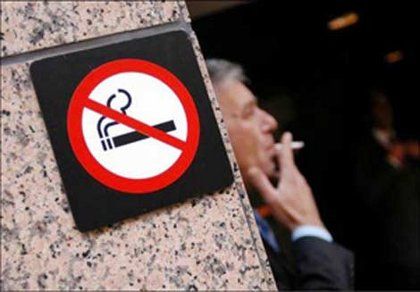Annika Sehn
From 19 July 2009, one of the most stringent smoking bans of all Europe became fully effective in Turkey. Since then it is much harder for stressed workaholics in the office, for the depressed unemployed in the “kahvehane” and for the nonchalant party animal at the favourite bar to have a good smoke. Also the to puff on the famous cigarette with coffee, the one after dinner or the other one, which goes along so well with playing cards or backgammon means, you have to be outside or at home. Even the traditional nargile, the water pipe, which was a feature of the Ottoman culture for 400 years is included in the ban, to the annoyance of many consumers. “For me it’s impossible to have a good conversation without smoking nargile,” Doğucan, 23, a guest in “Marakeş”, located in Kadiköy, complains. “In Belgium people meet to drink beer and here it’s the water pipe, which gathers people together. It’s part of our culture.”
Also in the “kahvehane”, where mostly men go to drink tea, play cards or backgammon and chat, smoking was more than a habit, if not an essential part of the coffee house tradition. Therefore, it has been the owners of these places, who came up with the loudest protest. Nearly 160 coffee shop owners, who light up in protest in the Marmara province Kocaeli at the beginning of August 2009 or a 10,000 strong rally in Ankara demanding the relaxation of the regulations by allowing separate “smoking sections” in coffee houses and bars are the most well known actions.
But somehow more interesting than the question whether the ban led to a drop in business, is how the ban is enforced or even if it is enforced at all.
An article in “Todays zaman” one month after the total enforcement of the ban claimed that the public compliance with the ban was about 100 percent. Experiencing the bar culture in Istanbul, this figure is hardly believable. On the fifth floor of a building mainly hosting bars you can still find ashtrays very frequently and in general the rule is: the higher you climb the stairs and the less well known the place is, the higher is the probability that you can have a smoke inside. Besides the part of the ban saying “including tents and sunshades” seems mostly not known and is violated in a widespread way.
From familiar friends you can hear the story of bar owners, who collects the ashtrays and politely ask you to stop smoking before the arrival of an official inspector, just to distribute them again after his departure. Yaşar, the owner of “Marakeş”, came up, like many others, with another idea: “I invested in outdoor heating, to make my customers feel comfortable, while smoking.” So while walking through “Balik Pazarii” or “Cicek Pasaji” and passing in front of “meyhanes”, which are now glowing in a warm orange light, emanating from various outdoor heaters, you won’t get cold even in wintertime. And nowadays you meet more and more happy salesmen of these heating systems in the streets. Their burgeoning business is visible on their smiling faces, although the ecological aspect of their ware is at least open to debate.
In other restaurants you can watch little crowds walking in and out within certain time periods, leaving one or two lonely, but proud nonsmokers at the deserted table. In Istanbul, a city which is lively and loud the whole night anyway, the chatting and smoking bunches of people on the streets are not a serious problem. This is different in smaller towns. “If you put tables outside, the neighbors complain. Who wants to see a couple of tables crowded with a bunch of men playing cards and smoking below their apartment?” Murat Ağaoğlu, the president of the Turkish Teahouses and Canteens Federation (TKKBF) is quoted in “Todays Zaman“ as saying.
Suat Karakaya, owner of a teahouse in Istanbul for 15 years, found a rather exceptional solution. As you could read in “Hurriyet Daily News“, he drilled two holes in a window and passed two thin hoses through each. A lit cigarette is attached to the end of one hose outside the window while the customer smokes comfortably from the other end inside the café. The second hose is for the smoker to exhale the smoke back outside.
As a last resort there is also the possibility to reduce or even stop smoking, which is one aim of the ban. Hüseyin, an owner of a small café in Istanbul, experienced this: “During my work, I’m not able to go outside very often, so instead of 2, I only smoke one package per day, of course it’s because of the ban.” This solution seems even more attractive in the year 2010, as the prices for cigarettes increased significantly due to a higher private consumption tax. Also the regulations referring to advertisement and warning signs on tobacco products are going to be more stringent.
It seems as if the year 2010 would challenge smokers and stay on track with the tendency of an increasing regulations. Probably a positive consequence will be the decrease of the consumption of cigarettes, which means on a long-term basis a fall in the number of smoking-related medical cases. But it certainly will cause the demise of a lifestyle.







